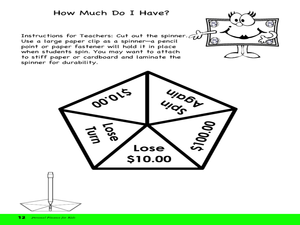Curated OER
Show Me The Money
Third graders explore the value of U.S. money. In this money lesson plan, 3rd graders print out pictures of money from the Internet and create play money. The students will play a game in which they display the amount of money called out...
Curated OER
Money Math Carnival
Third graders explore money in a carnival format. In this money lesson, 3rd graders create a carnival of mathematics activities. Students determine the value of money in mixed amounts and explore how to create representations of money.
Curated OER
Shopping for Candy
Students explore counting money. In this money counting and gingerbread house construction lesson, students use a calculator to determine how much and what type of candy they can buy given 25 cents. Students construct gingerbread houses...
Curated OER
How Much Money?
Sixth graders count money. In this money lesson, 6th graders count sets of coins and dollar bills. During specified activities, they total orders and calculate the amont of change a customer should receive. Students take turns...
Curated OER
It's On Sale
First graders read the book The Great Pet Sale to learn about economics and advertisements. In this economics lesson plan, 1st graders read the book The Great Pet Sale and define related vocabulary words. Students compare prices to find...
Curated OER
Buggin' Out (Identifying and Adding Amounts of Money)
Students explore consumer math by participating in estimate exercises. In this currency lesson, students identify and define each piece of U.S. currency and their value to the monetary system. Students complete several money worksheets...
Curated OER
Ch-Ch-Ching Cafe: Play Restaurant Make Change
Fourth graders make change by participating in a role-play restaurant activity. In this making change lesson, 4th graders use their math skills to compare prices and compute bills in a role play restaurant activity.
Curated OER
Money and Business (Art)
Third graders investigate world currency by creating their own coin art. In this government lesson, 3rd graders examine the characteristics of different coins and create their own design for a new one. Students discuss and present...
Curated OER
Counting Money
Young scholars discover the importance of economics through Shel Silverstein's poem Smart. Students are introduced to the concept of earning money and using money to purchase necessary items, after becoming familiar with U.S. money.
Curated OER
Spending Money
Students complete activities to study the value of money. In this money study lesson plan, students read a story about money and discuss how they earn money at home. Students watch a related video clip and create a class book about the...
Curated OER
Wealth
Third graders read the story The Day I Was Rich and learn about the role of money and taxes. In this money lesson plan, 3rd graders count large sums of money, group them, and give it away in the form of taxes. They discuss wealth and how...
Curated OER
Fraction Conversions
Learners convert between fractions, decimals, and percents using money. In this conversions lesson plan, students play with a mock store in class.
Curated OER
Problem Solving
Students use hockey sticks to pick up bean bags and put them into hoops which they get money for in the end. In this movement and math lesson plan, students get fake money and add up how much they earned in the end based on how many...
Curated OER
How Many Pennies?
Middle schoolers estimate the number of pennies it takes to fill outlines of various basic shapes.
Curated OER
Calculating Profits from Selling Virtual Lemonade
Students set up and collect data for a virtual lemonade stand. In this entrepreneurship, economics, and technology instructional activity, students purchase ingredients, determine costs, and set up a virtual lemonade stand. Students...
Curated OER
Budgeting 101
Students identify various sources of income and discern between needs and wants as they also learn to create a personal budget. In this personal budget lesson, student understand financial scenarios as they relate to different ways...
Mathematics Vision Project
Module 2: Systems of Equations and Inequalities
The brother-sister pair Carlos and Clarita need your class's help in developing their new pet sitting business. Through a variety of scenarios and concerns presented to the siblings, the learners thoroughly explore systems of equations...
Curated OER
Let's Try Various Calculations
Students explore math facts. In this calculation and math facts instructional activity, students play a board game in which addition, subtraction, multiplication, and division math facts are practiced. A copy of the game is included.
Curated OER
Logic and Problem Solving: Math Hunt
In these math lesson plans, students discuss how math problems are written to reflect real-world situations. They complete an online Math Hunt using specific web tools, and work individually to create their own Math Hunts. Additionally,...
Curated OER
Imaginary Wealth and a Magazine Article
Students explore economics by writing a fictitious news article. In this personal wealth lesson, students participate in a role-playing activity in which the year is 2025 and they must write an article about their extremely wealthy...
Curated OER
Reno's Dilemma
Students explain proportions as it relates to principle and interest. They use proportions to explain relationships and analyze relationships by identifying patterns.






















